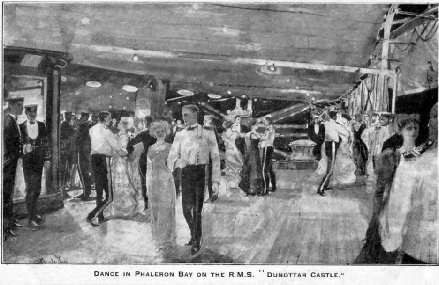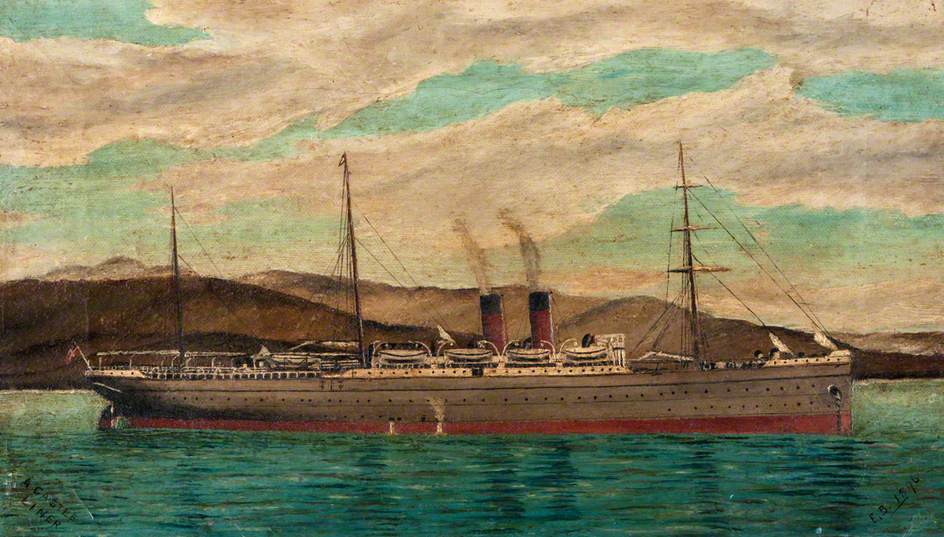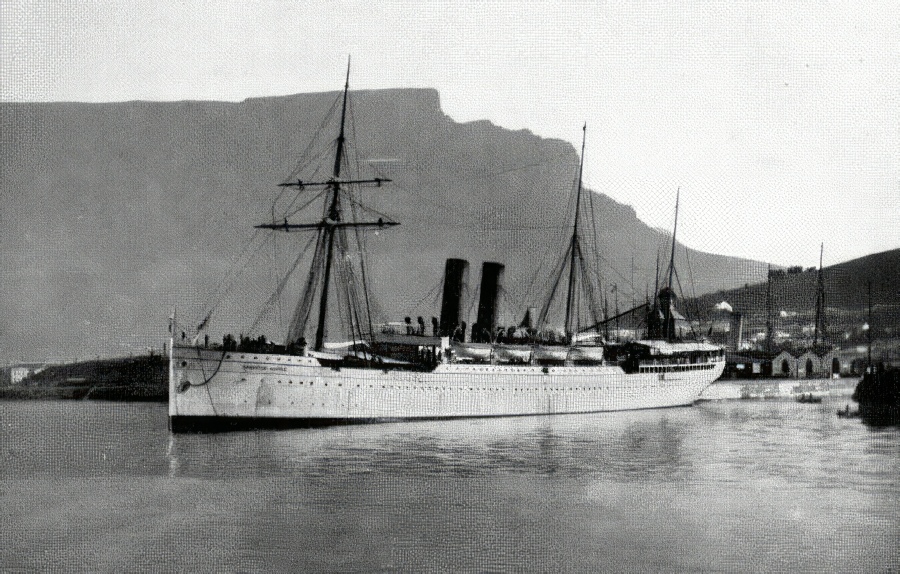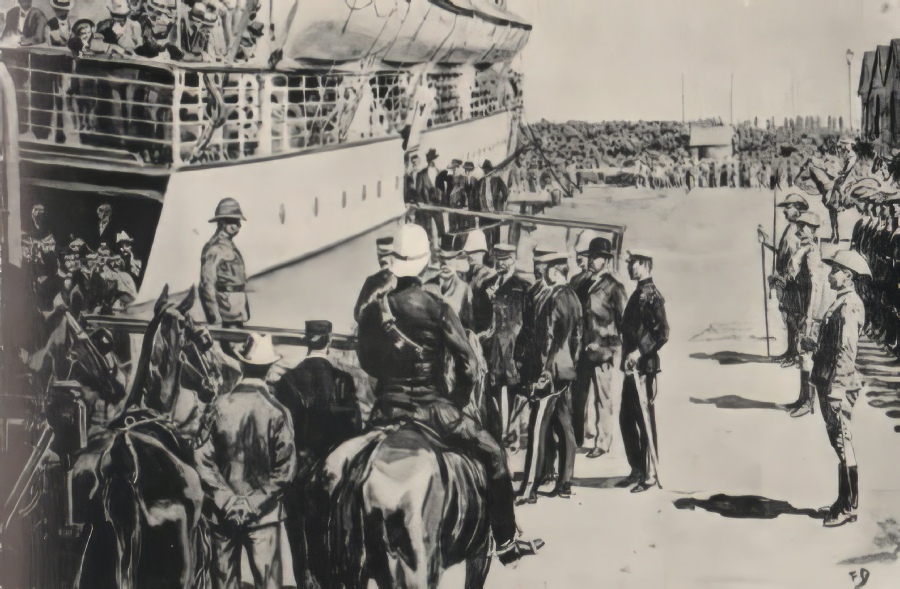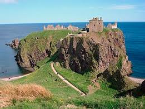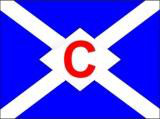IN the matter of a formal Investigation held at Westminster Town Hall, on the seventeenth day of September 1894, before R. H. B. MARSHAM, Esquire, assisted by Captains WARD and RONALDSON, into the circumstances attending the stranding of the British steamship "DUNOTTAR CASTLE," on the Eddystone, on the 24th August 1894, whereby she sustained serious damage.
Report of Court.
The Court, having carefully inquired into the circumstances attending the above-mentioned shipping casualty, finds, for the reasons stated in the annex hereto, that the cause of the casualty was that the master, Mr. Harry Rigby, who held a certificate of competency as master, No. 012,712, not accurately knowing his position, neglected to use the lead sufficiently, and steamed slowly ahead in a fog until the vessel took the ground.
The Court finds the master in default, and suspends his certificate for three months.
Dated this eighteenth day of September 1894.
(Signed)
R. H. B. MARSHAM, Judge.
We concur in the above report.
(Signed)
C. Y. WARD,
Assessors.
A. RONALDSON,
Annex to the Report.
This inquiry was held at the Town Hall, Westminster, on the 17th day of September 1894, Mr. W. Baden Powell appearing for the Board of Trade, whilst Mr. Butler Aspinall represented the master, and Mr. Samuel Garrett the owners of the "Dunottar Castle."
The "Dunottar Castle," official No. 98.152, is a steel screw steamship, built by the Fairfield Shipbuilding and Engineering Company, Limited, at Govan, Glasgow, in 1890.
She is of the following dimensions: Length, 420 ft.; breadth, 49.8 ft.; and depth of hold, 33.2 ft.
Her gross tonnage is 5,465.49 tons, and registered tonnage 3,069.27 tons. She is fitted with triple expansion direct-acting inverted engines of 6,700 i.h.p.
She is owned by Mr. James B. Smith and Mr. James Currie; Sir Donald Currie, K.C.M.G., M.P., of 3 Fenchurch Street, London, being the manager, and forms one of the fleet commonly known as the Castle Line.
She had 11 boats hung to davits and ready for immediate use. She had also all the life-saving appliances required by the Act and was in every way well equipped.
She was commanded by Mr. Harry Rigby, who held a certificate of competency as master, and had a crew of 156 hands all told.
She had also 215 passengers on board.
Her cargo consisted of about 500 tons of general with 137,000l. specie. She also carried the South African Mails.
She left Madeira on August 21st last, at 1.24 a.m., for London, calling at Plymouth to land mails and passengers. Her draft of water was 17 ft. 6 in. forward, and 21 ft. aft.
At 2.15 a.m. of the 24th of August last the Lizard Lights were sighted by the second officer, who was in charge of the watch, bearing N.N.W.
The master being then called came on deck, and remained on the bridge in charge of the navigation until the casualty occurred.
At 2,43 the Lizard Lights were abeam, bearing N.W. 1/4 N., at an estimated distance of 23 or 24 miles. A course was set N.E. 1/2 E. magnetic, the engines were at full-speed and making 16 knots an hour. The weather was fine and clear, with light airs and smooth sea.
At 3.20 a.m. Eddystone Light was sighted bearing N.E. 2/3 E. magnetic, at an estimated distance of about 20 miles. The course was altered to N.E. by E. magnetic, which course the master calculated would take the vessel 1 1/2 or 2 miles east of the Eddystone Rock. This course was continued at full speed until 4.15 a.m.
The Eddystone Light had been lost sight of at 3.40, the master thinking it must have gone out; as the atmosphere was apparently quite clear, vessels' lights being visible all round the horizon. But it is evident to the Court that the light had become enveloped in fog.
At 4.15 a.m. the course was altered to N.E. 1/2 E. magnetic, with a view of obtaining a sight of the lighthouse. But at 4.20 the master becoming convinced that a fog was obscuring the lighthouse hauled the vessel out to E.N.E., he then estimating his distance from Eddystone to be about 4 miles.
At 4.24 the vessel ran into fog, and the engines were reduced to "slow."
At 4.27 a cast of the lead was taken in 40 fathoms, but as the vessel had good way on, this sounding was admittedly unreliable.
At 4.32 the Eddystone Lighthouse fog-signal was heard in a N.E. direction. Another cast of the lead was taken at 4.37 in 35 fathoms, sand and shell.
After this the engines were kept going ahead and astern alternately for the purpose of using the steam and preventing the noise occasioned by blowing off.
According to the second engineer's evidence and the engineer's log-book the engines were at a standstill from 4.40 to 4.50.
The master stated that at 4.54 another cast of lead was taken in 35 fathoms, sand and shell, but according to the chief officer who took the sounding, this cast had been taken and reported to the master by 4.50. The Court thinks that this cast must have been taken at some time between 4.40 and 4.50.
The fog continued to be dense: but the master, on account of the depth of water reported to him, and of the apparent direction of the fog-signal which was heard about every five minutes, considered that the vessel was well clear of the rock.
At this time the vessel was heading about E. by S. or E.S.E. The engines were put "slow a-head," with the helm hard-a-starboard. The vessel came up a little, and in about a minute and a half the lower part of the lighthouse was seen right ahead. The engines were put full speed astern, but before the vessel lost her way she took the rock on the west side of the lighthouse, and remained.
It was not a heavy blow; the sea was smooth and the tide was rising. The boats were swung out ready for lowering, and one boat was dispatched in charge of an officer to Plymouth for the purpose of obtaining assistance.
The boat falling in with a pilot cutter, was taken in tow and returned to the vessel, which was then afloat, she having, on the rising of the tide, and with the assistance of the engines, which were going astern, floated off the rock at 6.10 a.m. The vessel's holds were sounded, and she was found to be making water in the fore-peak and chain-locker, but nowhere abaft the collision bulkhead.
The pilot took charge, and the vessel proceeded into Plymouth Sound, where she was anchored at 7.15 a.m. The mails and passengers were landed; a diver was employed to examine the vessel's bottom, and he reported the "fore-foot to be knocked up and two plates broken."
The master considering that there was no danger, she left Plymouth at 11.32 a.m. of the same day, and arrived on the 25th at 4 p.m. in London, where she was eventually placed in dry dock.
The stern was found to be broken two feet before the collision bulkhead, and one keel-plate holed in two places.
The damage, though material and serious, was not so grave as to prevent the vessel proceeding on and completing her voyage, but this was entirely owing to the fine weather prevailing and the smooth sea. Had the weather changed or the sea risen, not at all an uncommon occurrence in that locality, the vessel would probably have been wrecked and valuable life and property have been sacrificed.
Masters of vessels are not justified in approaching danger in a thick fog when they are uncertain of their exact position, but the Court, in suspending Captain Rigby's certificate for three months only, takes into consideration his excellent character and great length of service with the owners of the "Dunottar Castle," he having been 21 years in their employment, including 14 years in command.
The Court having been asked at the inquiry to express an opinion as to the advisability of connecting the Eddystone Rock Lighthouse with the shore by electric cable, it desires strongly to recommend to the Board of Trade that electric communication be made between the Eddystone Lighthouse and the main-land.
These were the facts of the case, and on the conclusion of the evidence Mr. W. Baden Powell, on behalf of the Board of Trade, put to the Court the following questions:
1. What number of compasses had the vessel on board, where were they placed, and were they in good order and sufficient for the safe navigation of the ship?
2. When and by whom were they last adjusted?
3. Did the master ascertain the deviation of his compasses by observation from time to time? Were the errors of the compasses correctly ascertained and the proper corrections to the courses applied?
4. Was the position of the vessel correctly ascertained at 3.20 a.m. on the 24th August?
5. Were safe and proper alterations made in the course at and after 3.20 a.m. of the 24th August, and were due and proper allowances made for tide and currents?
6. Were proper measures taken to ascertain and verify the position of the vessel at 4.24 a.m. and from time to time thereafter?
7. In what direction, and at what distance, was the fog-signal from the Eddystone heard?
Was the master aware of the caution issued by the Board of Trade in their Monthly Notices to Mariners, and whether, having regard to the terms of that caution, he placed too much reliance upon the sound of the fog-signal determining the position of the vessel?
8. Whether a good and proper look-out was kept?
9. Whether an efficient lead was used with sufficient care and frequency, and were correct soundings obtained?
10. What was the cause of the casualty?
11. Whether the vessel was navigated with proper and seamanlike care?
12. Whether the master and officers are, or either of them is, in default?
Mr. Garrett, Mr. Butler Aspinall, and Mr. Baden Powell having respectively addressed the Court, judgment was given as follows:
1 and 2. She had five compasses placed two being on the upper bridge (Sir William Thompson's patent), one on the lower bridge, an ordinary compass, and two spirit compasses aft. They were in good order and sufficient for the safe navigation of the ship. They were last adjusted six months ago by Lillie.
3. The master ascertained the deviation of his compasses from time to time; the errors were correctly ascertained, and the proper corrections to the courses applied.
4. At 3.20 a.m. of the 24th the position of the vessel was correctly ascertained.
5. A safe and proper alteration was made in the course at 3.20 a.m. and steered up to 4.15 a.m., after which time the alterations made were unsafe, and due and proper allowances were not made for tide.
6 and 9. The only measures that could be taken to ascertain and verify the position of the vessel at 4.24 a.m. and afterwards were casts of the lead; three casts were taken, one of which was admitted to be unreliable.
The Court considers that the lead used was an efficient one, but that it was not used with sufficient frequency.
The Court is not prepared to say that the soundings obtained were incorrect, but thinks that the last one must have been taken longer before the stranding than was stated.
7. The fog-signal from the Eddystone was heard by the master bearing N.E. at 4.32. The master stated that he estimated the distance to be about three miles.
The master was aware of the caution issued by the Board of Trade in their Monthly Notices to Mariners, and stated that he took it with other circumstances into consideration in estimating the position of his vessel.
8. A good and proper look-out was kept.
10. The cause of the casualty was that the master, not accurately knowing his position, neglected to use the lead sufficiently, and steamed slowly ahead in a fog until the vessel took the ground.
11. The vessel was not navigated with proper and seamanlike care after the fog set in.
12. The master alone is in default, and the Court suspends his certificate for three months.
(Signed)
R. H. B. MARSHAM, Judge.
We concur.
(Signed)
C. Y. WARD,
Assessors.
A. RONALDSON,

